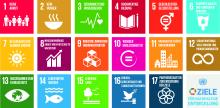Mit einem Sustainability-Assessment zur nachhaltigen Unternehmensstrategie
Sustainability Technical Textiles
Abstract
Die Textilindustrie gilt im Sinne der Nachhaltigkeit auf europäischer Ebene als Risikobranche. Warum das eine besondere Herausforderung ist und wie ein systematischer Ansatz zur nachhaltigen Transformation von Unternehmen aussehen kann, erfahren Sie in diesem Artikel.
Die Textilindustrie ist bekannt für ihre Innovationen und Ideen, die weit über die traditionellen Anwendungen von Bekleidung und einfachen Stoffen hinausgehen. Einige Beispiele sind der Einsatz von Glas- oder Carbonfasern zum Ersatz von Stahlbewehrungen in Betonbauteilen, künstliche Herzklappen aus Textilien oder Wasserstofftanks aus Carbonfasern. Allerdings steht die Textilindustrie vor großen Herausforderungen in Bezug auf Nachhaltigkeit. Sie ist weltweit eine der Branchen mit den höchsten Umweltbelastungen und hat auch erhebliche soziale Auswirkungen auf die Arbeitskräfte in der Lieferkette, die häufig auf Baumwollfeldern in Ländern wie China, Indien oder Pakistan beginnt. Hier ist ein systematischer Ansatz zur Nachhaltigkeitsbewertung erforderlich. Das Ergebnis der Nachhaltigkeitsbewertung bildet den Status Quo ab, kann als Benchmark im Vergleich mit anderen Unternehmen der Branche verwendet werden und bietet einen optimalen Ausgangspunkt für die Integration von Nachhaltigkeit in die Unternehmensstrategie.
Report
Einleitung
Aachen/München: Die Textilindustrie ist bekannt für ihre Innovationen und Ideen, die weit über die traditionellen Anwendungen von Bekleidung und einfachen Stoffen hinausgehen. Einige Beispiele sind der Einsatz von Glas- oder Carbonfasern zum Ersatz von Stahlbewehrungen in Betonbauteilen, künstliche Herzklappen aus Textilien oder Wasserstofftanks aus Carbonfasern.
Allerdings steht die Textilindustrie vor großen Herausforderungen in Bezug auf Nachhaltigkeit. Sie ist weltweit eine der Branchen mit den höchsten Umweltbelastungen und hat auch erhebliche soziale Auswirkungen auf die Arbeitskräfte in der Lieferkette, die häufig auf Baumwollfeldern in Ländern wie China, Indien oder Pakistan beginnt. Auch die weiterverarbeitenden Prozesse innerhalb der Wertschöpfungskette bergen die Gefahr unzureichender Umweltschutzmaßnahmen und der Missachtung international geltender Menschenrechte. Eine nachhaltige Textilindustrie hingegen setzt sich gezielt und insbesondere für den Einsatz von umweltfreundlichen Materialien, faire Arbeitsbedingungen und die Reduzierung des Energie- und Wasserverbrauchs ein. „Die EU verweist in ihrer neuen Sustainable Product Initiative nicht umsonst verstärkt auf ein hohes Maß an Umweltschutz und notwendige Verbesserungen der Umweltqualität. Wir müssen an den wichtigen gesellschaftlichen Herausforderungen forschen und neue Technologien schnell in die Umsetzung bringen“, so Prof. Thomas Gries vom Institut für Textiltechnik (ITA) der RWTH Aachen University.
Systematischer Ansatz zur Nachhaltigkeitsbewertung
Auf Unternehmensebene fängt die Transformation mit der Erfassung der notwenigen Daten (Indikatoren) und der der daraus resultierenden Messbarkeit der eigenen Nachhaltigkeitsleistung an. Die TÜV SÜD Industrie Service GmbH hat dazu eine Methodik entwickelt, die in Zusammenarbeit mit dem ITA für die Textilindustrie adaptiert und optimiert wurde: die Nachhaltigkeitsbewertung orientiert sich an den 17 Sustainable Development Goals (SDG) der Vereinten Nationen. Auf der Grundlage verschiedener Indikatoren, die durch Branchen- und Ländervergleiche gewichtet werden, wird die Nachhaltigkeitsleistung des Unternehmens objektiv, unabhängig und transparent beurteilt. „Mit unserer Nachhaltigkeitsbewertung ermöglichen wir allen relevanten Akteuren der Wertschöpfungskette Klarheit über den Ist-Zustand der unternehmensspezifischen Nachhaltigkeit zu erlangen, die wesentlichen Nachhaltigkeitsrisiken zu identifizieren und mit den daraus abgeleiteten Verbesserungsmaßnahmen einen wesentlichen Schritt in Richtung eines Nachhaltigkeitsmanagementsystems zu gehen“, so Lucas Wagner von der TÜV SÜD Industrie Service GmbH. Dieser Ansatz umfasst die gesamte Unternehmensstrategie und ist auch für andere Branchen einsetzbar.
Integration von Nachhaltigkeit in die Unternehmensstrategie
Das Ergebnis der Nachhaltigkeitsbewertung bildet den Status Quo ab, kann als Benchmark im Vergleich mit anderen Unternehmen der Branche verwendet werden und bietet einen optimalen Ausgangspunkt für die Integration von Nachhaltigkeit in die Unternehmensstrategie. Die objektive Bewertung bietet zunächst die Möglichkeit, notwendige Schwerpunkte für die Transformation hin zu einem nachhaltigen Unternehmen zu identifizieren. Zusammen mit externen Experten, z. B. aus der Forschung, werden Potentiale identifiziert und konkrete Umsetzungsmaßnahmen abgeleitet. „Das Vorgehen bietet einen holistischen Ansatz, um die nachhaltige Transformation zu einem Kern der Unternehmensstrategie zu machen. Die Wirtschaftlichkeit bildet dabei eine wichtige Säule“, so Prof. Gries. Darüber hinaus bietet die Nachhaltigkeitsbewertung durch die TÜV SÜD Industrie Service GmbH eine ausgezeichnete Ausgangslage, um die Anforderungen der CSRD, also der „Corporate Sustainability Reporting Directive“ zu erfüllen. So wird Nachhaltigkeit zu einem planbaren Erfolgsfaktor für Unternehmen.
Bildunterschriften:
Abbildung 1: 17 Ziele für nachhaltige Entwicklung (SDG) der Vereinten Nationen (Quelle: Vereinte Nationen)
Abbildung 2: Methodischer Ansatz für die Nachhaltigkeitsbewertung eines Unternehmens (Quelle: TÜV SÜD Industrie Service GmbH)
Abbildung 3: Wesentlichkeitsanalyse und Strategieentwicklung (Quelle: TÜV SÜD Industrie Service GmbH)
Contact: florian.pohlmeyer@ita.rwth-aachen.de
1: Institut für Textiltechnik der RWTH Aachen University, Otto-Blumenthal-Str. 1, 52074 Aachen
2: TÜV SÜD Industrie Service GmbH, Westendstraße 199, 80686 München
More entries from ITA Institut für Textiltechnik der RWTH Aachen University









